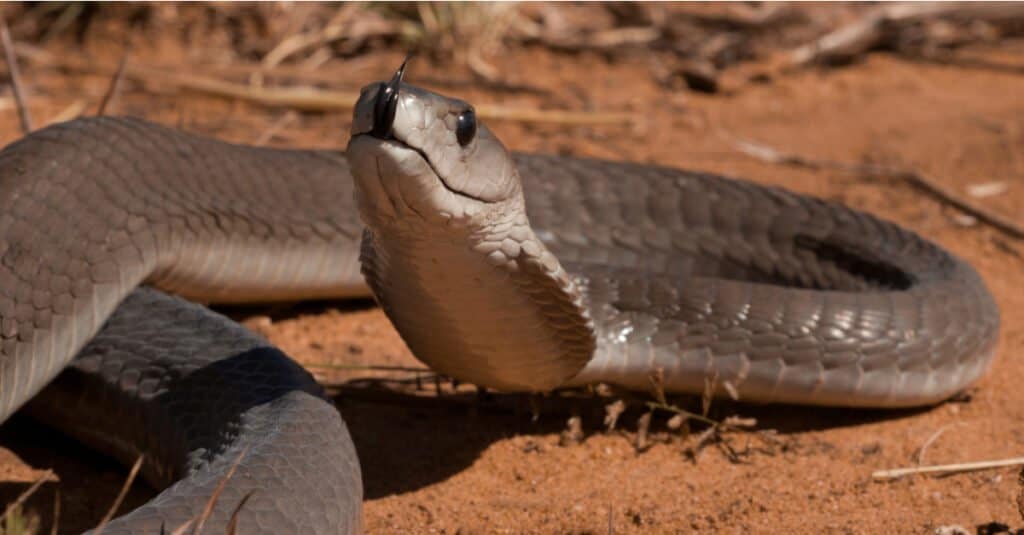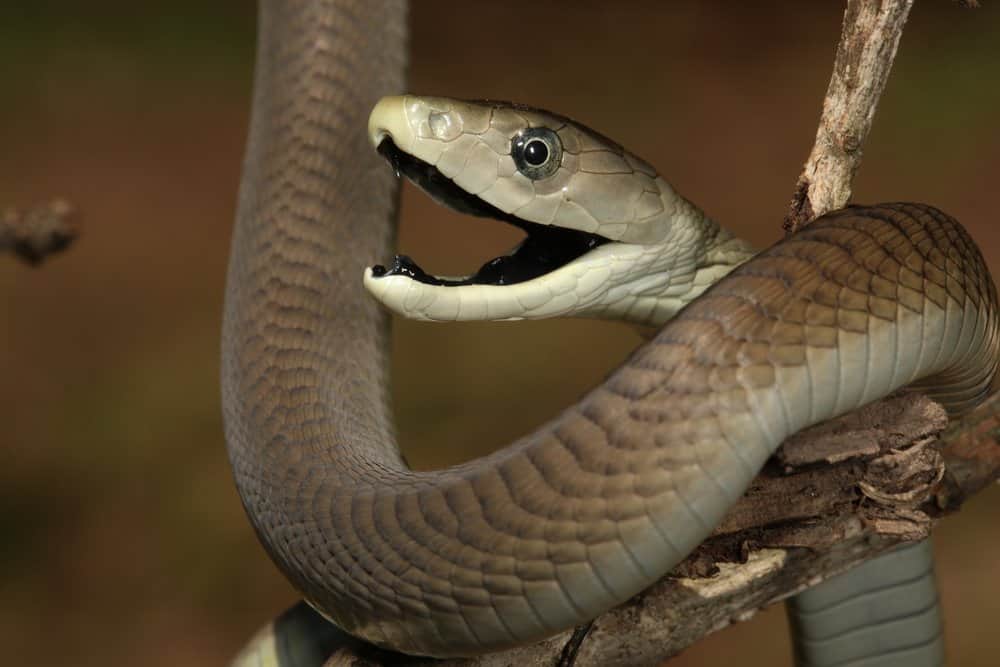Snakes are unique creatures with intriguing features that constantly remind us of the many differences between them and humans. They crawl on their bellies, smell using their tongues and the Jacobson organ, and may produce venom. Another unique and underrated feature that snakes possess is the ability to have tongues with individual and multiple colors.
Unlike humans limited to one tongue color (pink), some snakes have cream, blue, or red tongues, while some mix up to two of these colors. More interestingly, some snakes have pitch-black tongues. Although not many studies have focused on the colors of snakes’ tongues, we’ve gathered enough information to thrill you. This article takes a look at the snake with a dark, black tongue.
Do Any Snakes Have Dark, Black Tongues?

The only snake known to have a black tongue is a black mamba. Black mambas have an entirely inky-black mouth, and this is where they get their name from. When black mambas are threatened, they open their coffin-shaped mouths wide to expose their black mouths, which scares predators away.
Black Mamba Snakes

When threatened, a black mamba will often spread a narrow cobra-like hood.
©131346563/Shutterstock.com
Black mambas are highly venomous elapids. They are thin and lithe snakes found all over Sub-Saharan Africa. They are recognized as the second-longest venomous snakes, just after king cobras. Black mambas are terrestrial and arboreal, unlike many other snakes known to live both on land and in water.
This means that they live both on land and in trees, making them excellent climbers. Can you imagine climbing a tree and coming across one of the most venomous snakes in the world? Although black mambas are recognized for their aggressive natures, they are known to only bite humans when they feel threatened.
How to Identify Black Mamba Snakes

Black mambas are long and slender snakes that grow between 6 ft 7 inches to 9 ft 10 inches in length.
©NickEvansKZN/Shutterstock.com
Their mouths aren’t the only way to identify the species. Black mambas are long and slender snakes that grow between 6 ft 7 inches to 9 ft 10 inches in length, although species up to 14 ft have been discovered. Weight-wise, these snakes measure 2.3 to 3.5 pounds on average.
Black mambas have long and thin tails that make up almost a quarter of their length. They can be a wide range of colors, from yellowish-brown to olive and khaki. However, the color of their mouths remains the same. They also have grayish-white underbellies, but their eyes’ color is highly variable. They could be black to grayish black, with the pupils encased in yellow or silver.
Where Are Black Mambas Found?
Generally, black mambas inhabit sub-Saharan Africa. Some countries where they can be found are Burkina Faso, the Central African Republic, Cameroon, the Democratic Republic of the Congo, and South Sudan.
Black Mamba Venom
The black mamba’s venom is known as the deadliest in Africa, despite the absence of protease enzymes in its composition. Black mambas are known and feared in the continent, giving rise to tons of myths about the snake- and it’s quite easy to understand why. In South Africa, 2,553 venomous snakebites were recorded between 1957 and 1979. Of this number, black mambas were named responsible for 75. Sixty-five of this number had the classic symptoms of black mamba envenomation, and sadly, 21 people did not survive the bites.
In 1962, black mamba antivenom was created but even then, 5 out of 38 persons given the venom died. Without a doubt, these snakes are deadly. So just what are their venom made of?
Black mamba venom is primarily neurotoxic. Neurotoxins work by attacking the nervous system, which stops the transmission of signals from the victim’s nerves to muscles, thus causing paralysis. Neurotoxic venom, also known as one of the fastest-acting venoms, begins working from the head before spreading to the rest of the body. When the effects spread to the diaphragm muscles, the victim will be unable to breathe. Neurotoxins kill quickly and easily. In black mambas, victims begin seeing the venom’s effects in under ten minutes.
Black Mambas Bite
Black mambas are quick snakes that can move at a maximum speed of 20 mph. However, due to their lithe bodies, they have an exaggerated reputation concerning their readiness to attack. Firstly, as we have stated before, these snakes rarely attack, whether accidental or otherwise, without provocation. Secondly, before a black mamba bites, it makes a show of opening its mouth to reveal its inky blackness before finally striking. However, when they do strike, it is a quick affair.
Unlike many other snakes, the bite of a black mamba may not cause swelling — but do not let this fool you; effects of the species’ venom can kick in within 10 minutes. Black mambas are known to bite repeatedly, which hints at their proteroglyphous fangs. Like most elapids, black mambas have proteroglyphous fangs (similar to coral snakes). They are short and fixed but emit venom at faster rates. The major symptom reported by bite victims leading up to the effects of the venom is a tingling sensation. In addition, since black mambas bite repeatedly, it is not uncommon to have multiple bite wounds.
Black Mambas Venom Yield
Black mambas have an average venom yield of 100–120 mg with a maximum of 400 mg. To determine its lethal dose, a group of Kenyan researchers, using mice, launched a study into the black mamba’s venom in 2019.
They calculated its lethal venom dose to be about 0.15mg/ pound. This means that if you weigh 180 pounds, just 27 mg of venom would be fatal. Considering the black mamba’s maximum venom yield, it is safe to say that they are capable of killing far more than 10 men (closer to 15) with a single bite, beating the coral snake’s toxicity.
What To Do If You Are Bitten By A Black Mamba
Although black mamba bites are extremely rare outside Africa, being prepared in the event of one is a safe idea. If you’ve been bitten by a black mamba snake, here are some helpful tips that can save your life:
- Exit the snake’s territory and contact emergency services ASAP. It is very important to contact emergency services and inform them that you’ve been bitten by a black mamba.
- Stay calm and relaxed. Moving around helps the circulation of the venom.
- Do not attempt to treat the bite.
- Ensure that the bitten place isn’t raised above your heart. The aim is to keep the venom away from your heart.
- Do not move around. Moving around can help the snake’s venom circulate.
- Do not try to cut the bitten part off, as it will lead to blood loss or other irreversible complications.
Simply stay calm and wait for help. Modern medicine has evolved, making doctors fully capable of saving your life, if you do the needful.
The photo featured at the top of this post is © NickEvansKZN/Shutterstock.com
Discover the "Monster" Snake 5X Bigger than an Anaconda
Every day A-Z Animals sends out some of the most incredible facts in the world from our free newsletter. Want to discover the 10 most beautiful snakes in the world, a "snake island" where you're never more than 3 feet from danger, or a "monster" snake 5X larger than an anaconda? Then sign up right now and you'll start receiving our daily newsletter absolutely free.
Thank you for reading! Have some feedback for us? Contact the AZ Animals editorial team.







